There is so much buzz going on about the Lion’s mane mushroom and I thought that I would share my knowledge with you about this amazing mushroom. Lion’s Mane mushrooms have many brain and gut health benefits and soon it could be growing in your backyard or even your kitchen counter in the near future.

Why is it called Lion’s Mane?
The shape of this funky looking fungus is similar to the mane of a lion. There is no other way to describe it, it looks like nothing else! It has long spore producing spines that cascade downwards and when you see it you will be tempted to pet it like a cat or a friendly lion.
Lion’s Mane mushroom is a cool weather fruiting fungus, that you will usually find pretty high up in trees that are either on their way out or already dead. And sometimes they even find homes in the wounds of trees, where a limb has previously fallen from, and exposed the tree to infection.
If you are lucky like some people I know, you can find massive ones, 5 lbs or more. They can get quite hefty. Lion’s Mane will grow on the same trees for many seasons. Later this week I am going to do some drive by mushroom hunting in my neighborhood to check a few trees.
When I spot a Lion’s Mane, I don’t care how high up in the tree it is, I will sit there and figure out a way to get to it. Sticks, ropes, ladders, rocks, can’t miss the opportunity. If I am still not able to get to it, you bet I will be calling my dad, because he will know the way LOL!
Wish me luck!!!!
The Many Types of Lion’s Mane
𓍊𓋼𓍊𓋼𓍊
Hericium erinaceus – POM POM
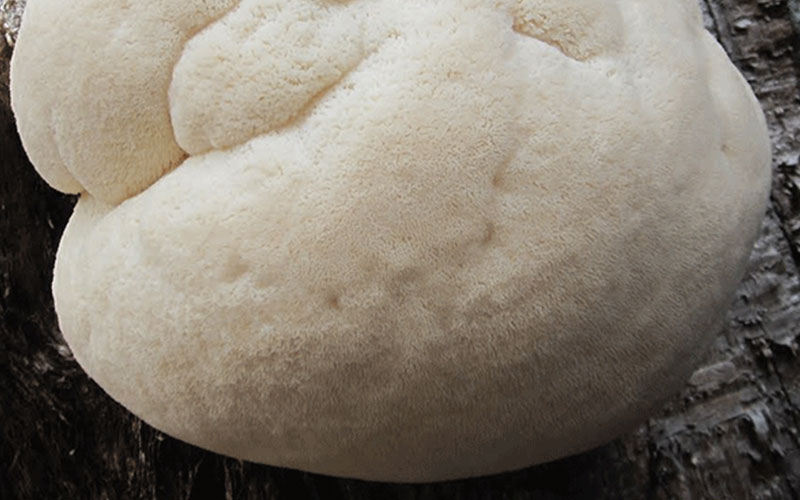
A mushroom that tastes like crabmeat? Hericium fruit have spines, not gills, and can be found fruiting on a variety of hardwood trees. Nearly identical in appearance and flavor to other Lion’s Manes, this slight species variation differs from H. americanum in that this species forms a perfect singular ball of spines. Tearing this mushroom into strands and sautéing with butter and garlic tastes nearly identical to crabmeat or lobster! Great mushroom for anyone with shellfish allergies that wish they could eat shrimp or other seafood. Yo can try coating slices into egg, breading and frying them, pairing with a spicy mayo sauce for dipping.
𓍊𓋼𓍊𓋼𓍊
Hericium americanum – Tufted Lion’s Mane
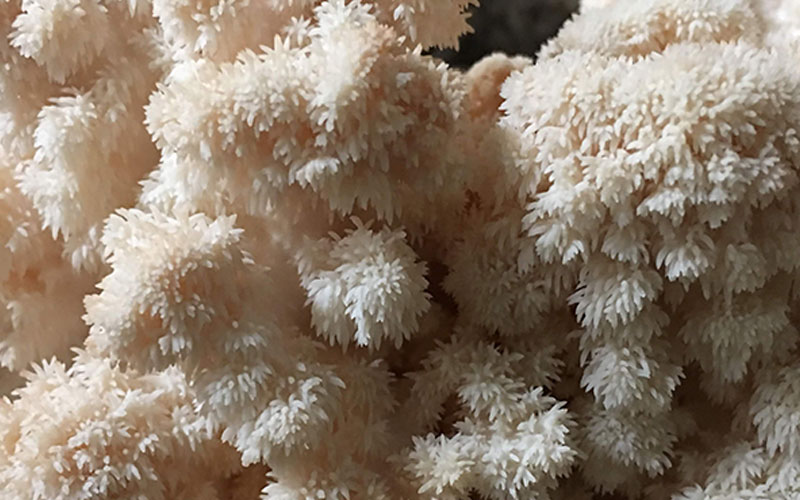
This one also has a texture and taste of crabmeat. Become a believer and this will be one of your favorite edible mushrooms that you ever grow. Hericium fruit have spines, not gills, and can be found fruiting on a variety of hardwood trees. Nearly identical in appearance and flavor to other Lion’s Manes, this slight species variation differs from H. erinaceus in that this species forms tight branches on the ball of the fruitbody. This mushroom is excellent in pasta dishes and will leave everyone at the table stealing the delicious chunks out of any dish you prepare.
𓍊𓋼𓍊𓋼𓍊
Hericium corraloides – Coral Tooth
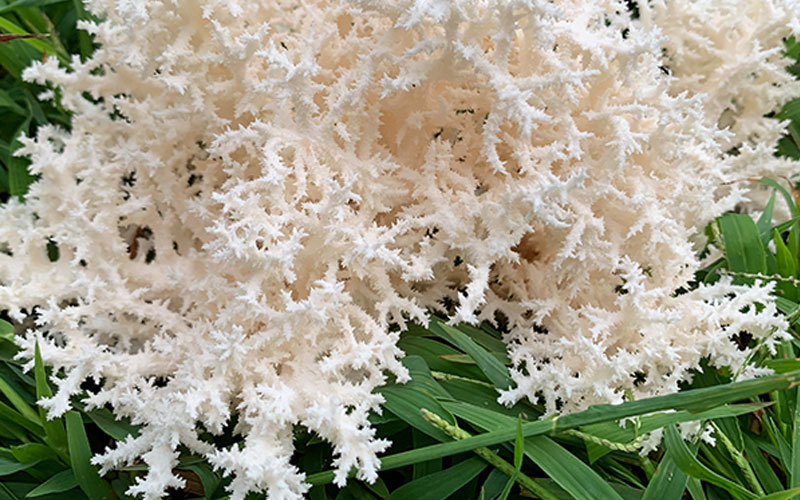
This is one of my more favorites lion’s mane types. It tastes somewhat sweeter than the POM POM, and has a mild and nutty taste. Coral Tooth grows on hardwoods, and it crumbles when picked. This one is formerly known as Hericium ramosum. Pick them before they discolor to a yellow color, as they might taste a bit unpleasant.
𓍊𓋼𓍊𓋼𓍊
Hericium abietis – Conifer Coral
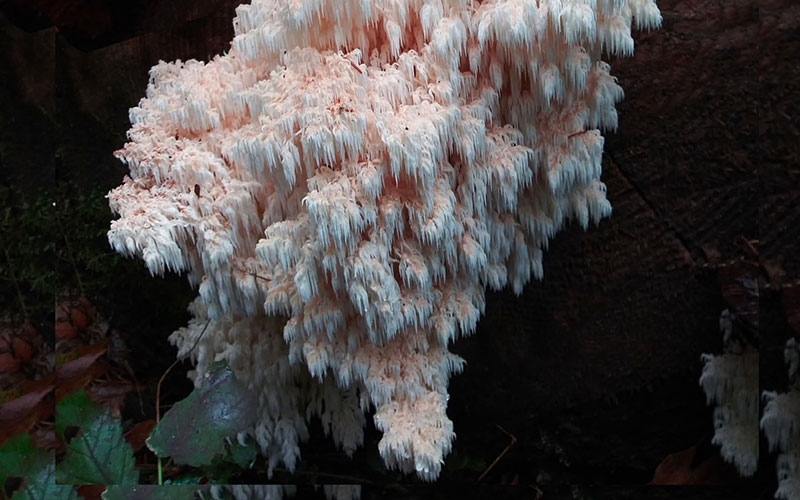
This type of Hericium is found growing on conifer logs – choice edible, producing a cream white fruit body up to 4–30 inches tall and wide. It is rich in protein and fiber, and like the other types of this toothy fungus, it can be substituted as a vegetarian choice for crab meat.
𓍊𓋼𓍊𓋼𓍊
“Food is Medicine”
Brain Benefits

According to WebMD, lion’s mane is rich in thiamine, (Vitamin B, cannot be made by your body, helps turn food into energy and keeps the nervous system healthy), riboflavin (antioxidant which can help fight free radical damage, and helps turn folate and vitamin B6 into forms that your bod can use), and niacin (another vitamin B3, that helps turn food into energy).
But what lion’s mane is really known for is hericenones (fruiting body) and erinacines (mycelium).

Hericenones
Mouse studies have shown that hericenones which are found in the fruiting bodies of the mushroom can help reduce neuronal death and promote neurite outgrowth in the brain. According to pubmed, aqueous preparation of H. erinaceus offers neurotrophic activities, which is important in promoting the growth and differentiation of neurons. Hericenones are not responsible for neuroprotective activities.
Erinacines
On the other hand, erinacines (diterpenoids) which are rich in the mycelium of Hericium have shown to help with neurodegenerative disorders. There is no evidence yet that erinacines can be absorbed into the blood capillaries and pass the blood brain barrier, but studies are showing that in an experimental model of a stroke, erinacines, specifically erinacine A has shown that it is effective in reducing neurodegenerative disease-induced cell death. When looking for mycelial extracts, do your research and look for ones where mycelium is grown in liquid culture and not on grains.
For more comprehensive reading about potential health benefits of lion’s mane for brain health, please visit this article: https://www.ncbi.nlm.nih.gov/pmc/articles/PMC5987239/
Gut Benefits

Lion’s mane not only provides potential health benefits for our brain, but also our second brain, the gut.
Straight from Sam Blackstone’s (Mindful Mycology) lecture on medicinal mushrooms he did for SCUMS just this month, lion’s mane protects the GI tract and gut’s mucous lining against cancer, ulcers and inflammation linked to inflammatory bowel disease and colitis. One study found bifidobacterium (a “good” bacteria in your gut) flourished and inflammation and tissue damage to gut lining diminished with use of Lion’s mane.
Click here to read more about lion’s mane and its healthy effects on our guts: https://www.ncbi.nlm.nih.gov/pmc/articles/PMC5689651/
Ingesting lions mane fruiting bodies and mycelium comes with no known side effects. But it is important to be mindful if you are taking medicines like anticoagulants and antidiabetics. Talk to your doctor before starting on any supplements.
Growing Lion’s Mane
You might ask: “What if I can’t find my own lions mane in a tree” my answer to you is that you can grow it. There are several methods.
Growing Lion’s Mane from a fruiting kit
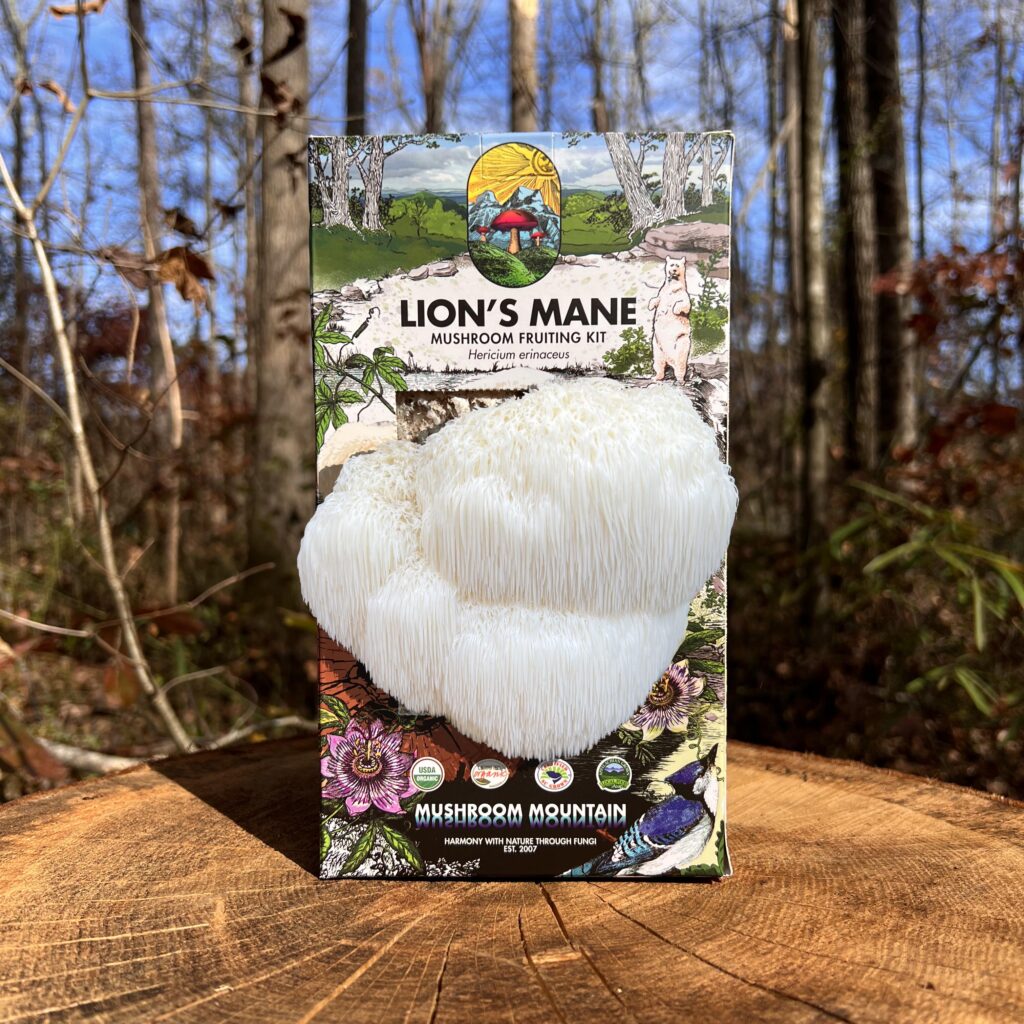
First method is to simply purchase a fruiting kit. Mushroom Mountain makes them with certified organic products, and biodegradable packaging. And growing them on your kitchen counter is really easy. You just cut a hole, spray with water and watch it grow.
Our directions are very simple to follow. We will send you a hard copy with your kit. For a quick preview of the growing directions, please click here: https://mushroommountain.com/wp-content/uploads/2023/11/LionKitInstructionLOW.pdf
Purchase fruiting kit link: https://shop.mushroommountain.com/collections/indoor-fruiting-kits/products/lions-mane-mushroom-fruiting-kit
Growing Lion’s Mane from an inoculated log
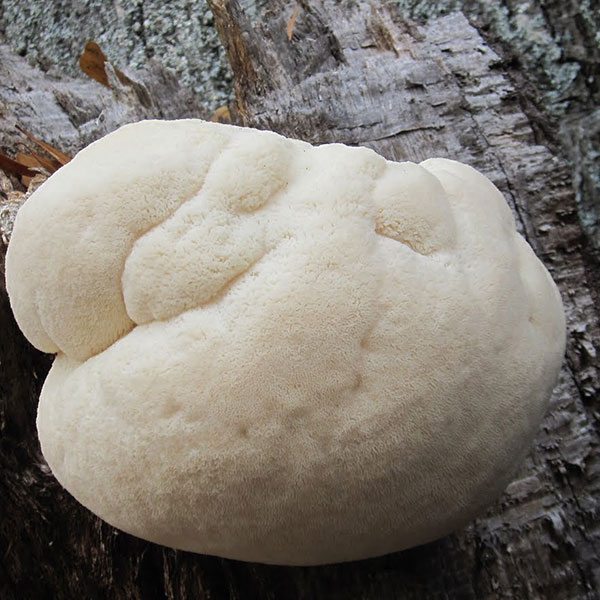
Growing from a log is a little more involved than fruiting from a kit, but the return pays off in the long run. For every inch diameter of the log you are planting, you will get a year of fruiting.
I try not to plant logs that are 8” or more in diameter, because they take too long to colonize. Anywhere from 4-6” is great, and it will take anywhere from a year to year and a half to colonize and fruit.
Lion’s Mane will fruit well on the following types of wood:
- POM POM, Tufted Lion’s Mane, and Coral tooth: Black walnut, oak, beech, elm, maple, cherry
- Conifer Coral: Conifer stumps & logs, and fir
The instructions for planting on logs is outlined in this handout: https://mushroommountain.com/wp-content/uploads/2023/01/PluggingLogsLOW.pdf
Purchase plugs link: https://shop.mushroommountain.com/collections/plug-spawn/products/lions-mane-mushroom-plug-spawn-heiricium-spp
In summary, we have learned what Lion’s Mane looks like, it’s health and nutritional benefits, how to grow it, and now let’s learn how to cook them.
Recipes
Mock crab cakes are one of the most popular recipes out there for Lion’s Mane, so I offer you three different recipes from the Mushroom Mountain staff. Enjoy!
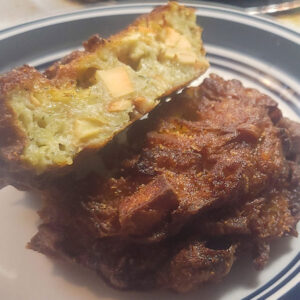
Barry’s Crab Cakes
- Cube 1lb lions mane into 1in cubes
- In large pan, cook lions mane in 1/4 cup of butter on medium low heat, stirring often, until just barely browned. Remove from heat. (If the mushrooms quickly soak up butter, leaving the pan dry, add more butter)
- In a small bowl, whisk together 2 eggs, 1/2 cup mayonnaise, 1 tablespoon worchestershire sauce, 1 teaspoon hot sauce, 2 teaspoons seasoned salt (tony chacheres or old bay), 1tablespoon dill, and 1 tablespoon stone ground mustard.
- In a large bowl place your cooked lions mane and 1 and 1/2 cup panko bread crumbs. Fold in the bowl of whisked egg mixture.
- Make into patties and fry in 2 inches of neutral oil until flipping every couple minutes or so until golden brown on both sides.
- Serve with lemon wedges and tarter sauce.
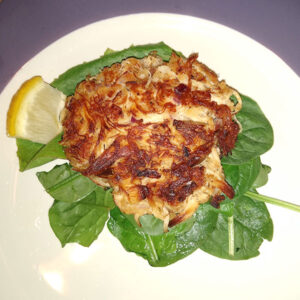
Lizza’s Crab Cakes
- 16 oz Lion’s Mane fruiting body, shredded
- 2 cups seasoned breadcrumbs
- 2 tsp. soy sauce
- 2 tsp. stoneground Dijon mustard
- 2 tsp. Old Bay seasoning
- Sprinkle of garlic powder
- 4 eggs
- 1/2 cup flat leave parsley, chopped
- 1/2 red bell peppers, diced
- 1 medium onion, diced
- 2 celery stalks, chopped
- 1 tbsp. olive oil and 1 tbsp. butter for frying veggies, plus more olive oil to pan fry crab cakes
- Freshly ground pepper
Preparation:
- Over med-high heat, in a medium size pan, heat up 1 tbsp. olive oil and butter, add celery, onion and bell pepper, sweat for about 3-4 minutes. Let it cool.
- In a large bowl, combine Lion’s Mane and all the remaining ingredients. Add the veggies, and mix well. Form patties, just like you would make a hamburger, place on a tray and chill in the fridge for at least 20-30 minutes.
- Heat up enough olive oil to cover the bottom of a large pan, on medium high heat, (make sure the oil is hot) place at the most, 4 patties, AND LOWER HEAT TO MEDIUM, otherwise, crab cakes will come out too dark. Cook on one side for 4 minutes, then flip gently with a spatula and the aid of a fork, cook on the other side for 2 minutes. Remove promptly. Repeat. You can also broil them for a healthier version.
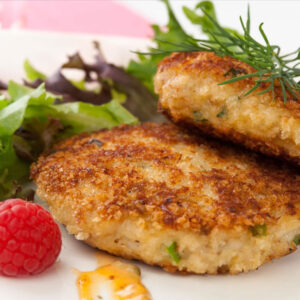
Megan’s Mock Crab Cakes
This recipe is delicious, easy to prepare and sure to please. Can be made ahead or even frozen before cooking. Smart and tasty way to get kids to eat mushrooms!
*This recipe was developed with our dried Lion’s Mane in mind. It can definitely be made with fresh Lion’s Mane and if your looking for next level add some real crab! Slice 1/4 to 1/2 lb fresh Lion’s Mane into 1/4 inch slices, toss with 1-2 TBS olive oil and roast with garlic flipping slices halfway through. Pulse together in the processor and skip the oil unless a little extra is needed to incorporate.
*Makes 4-6
Ingredients
- 2-4 cloves garlic, unpeeled
- 1 egg (for vegan use flaxseed egg)
- 3 TBS greek yogurt
- 2 tsp dijon mustard
- 2 tsp worcestershire sauce
- 2 tsp lemon juice + a little lemon zest
- 1 1/2 tsp Old Bay seasoning
- 1/4 tsp salt
- 2 cups dried Lion’s Mane
- 2 TBS olive oil
- 1 cup panko, breadcrumbs or cracker crumbs
- 1 TBS fresh chopped parsley or 2 tsp dried
- Coconut oil or other oil for frying
(Can brush with butter or oil and bake instead)
Directions
- Roast garlic in a 375-degree oven, drizzled with a little oil for 30-45 minutes until golden.
- Whisk together egg, yogurt, mustard, worcestershire, lemon juice and zest, Old Bay and salt in a medium sized bowl, set aside.
- Place roasted garlic in a food processor and pulse 3-4 times. Add Lion’s Mane and olive oil and pulse another 2-3 times. (For chunkier “meat”, just pulse garlic and oil)
- Add Lion’s Mane, garlic, parsley and panko or alternative to the bowl, fold together. Cover and refrigerate for 30 minutes or up to one day. (This is optional but will help form even cakes)
If baking, preheat oven to 450 degrees.
- Form into 6 medium or 4 large, equally portioned cakes.
- If frying, heat oil in a pan over medium heat. Add cakes and brown about 2 minutes per side.
- If baking, add cakes to a lightly buttered pan, brush tops with butter and place in oven for 12-14 minutes.
- Optional – finish with a touch of sea salt and/or a drizzle of fresh lemon juice.
Until next time, I salute you my beautiful mushroom family!
Hugs, Olga

2 thoughts on “It’s Lion’s Mane Season”